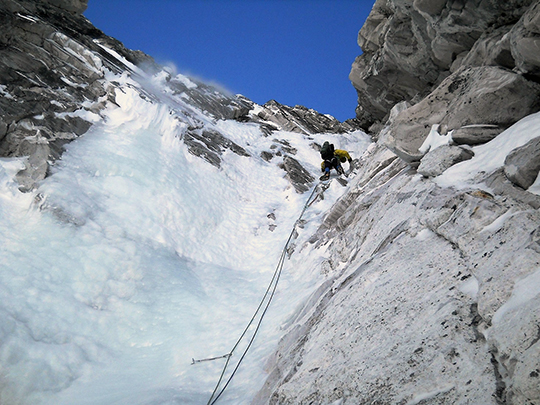
[Photo] Mikhail Fomin/ Nikita Balabanov collection
Two Ukrainian climbers made the first ascent of the long, difficult north-northwest pillar of Mt. Talung, a 7348-meter peak on a ridge that juts south from Kangchenjunga and forms part of the border between Nepal and Sikkim, an Indian state.
Between October 18 and 25, Mikhail Fomin and Nikita Balabanov climbed the 2350-meter pillar, calling their route Daddy Magnum Force (M6 AI6 A3; with an overall route difficulty of ED2). Fomin and Balabanov reported the route was very steep and reminiscent of winter climbing around Chamonix but “with heavy packs and [at elevations] higher than 6000 meters.”
“The route showed both of us how much we still have to learn in the Himalaya and how much we already can do,” Fomin said in an email interview with Alpinist. “Each of us lost ten to fifteen kilograms of weight during the ascent. The experience and huge motivational charge we received at the end was really worth it.” The route is a notable prize for the Ukrainians as interest in the buttress has heated up during the past decade, especially among European alpinists.
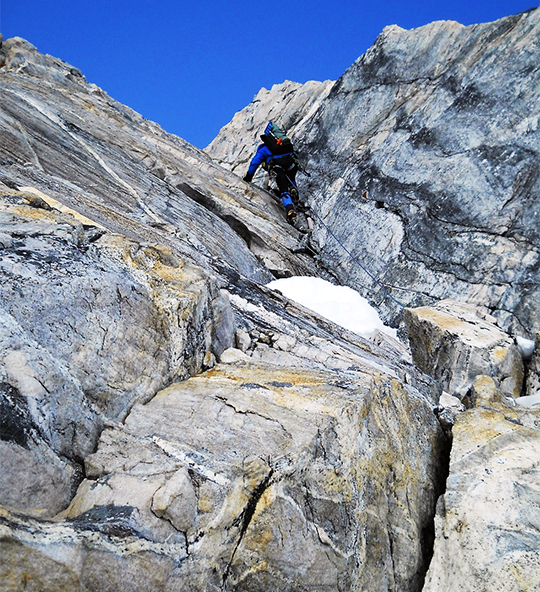
[Photo] Mikhail Fomin/ Nikita Balabanov collection
Mt. Talung’s north side boasts two prominent spurs, both around 2000 meters high: the striking north-northwest pillar and the less attractive northwest spur.
Attempts on Mt. Talung’s prominent spurs:
2002: Czechs Alena Cepelkova and Petr Kolouch climbed 500 meters of the north-northwest pillar but retreated because of poor snow conditions.
2004: Czech climbers Marek Holecek and Tomas Rinn tried the elegant north-northwest pillar but while belaying Rinn, Holecek suffered frostbite in his toes and the pair backed off. Holecek had hoped to return in 2008, but was unable to finance a trip.
2013: Holecek and Rinn returned but found the north-northwest pillar out of condition, so they climbed the scary face to the left of the pillar, a route featuring a massive hanging serac about a third of the way up. They completed the new route in six days.
2014: Three Italian climbers, Daniele Bernasconi, Giampaolo Corona and Mario Panzeri, also attempted the pillar.
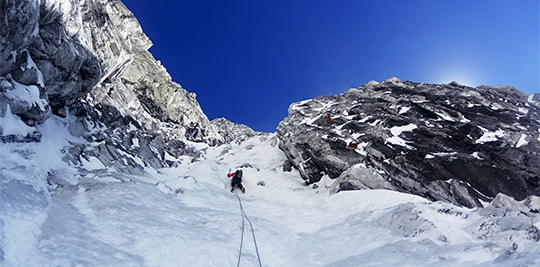
[Photo] Mikhail Fomin/Nikita Balabanov collection
“The line was capturing more and more attention from strong teams,” Fomin said, noting that it was a “now-or-never” situation.
After learning that the Kangchenjunga region of the Himalaya remained open to climbing after the April 2015 earthquake, “there were no doubts which mountain we should try to climb,” Fomin wrote on mountain.ru. “After our first ascent of Langshisa Ri’s (6427m) northwest spur last year, we felt that we [were] ready for some larger targets and could climb more technical terrain at a higher altitude. Mt. Talung seemed to be the ideal choice for us.”
Fomin and Balabanov established base camp at Oktang (below the south face of Kangchenjunga) on September 28, and then spent two weeks acclimatizing. This included an ascent of Boktoh Peak (6145m) and a partial ascent up the west side of Mt. Talung, their planned descent route, to a bivouac at 7100 meters.
After acclimatizing, the pair was ready but a spell of bad weather grounded them, allowing some needed rest. After three days in base camp, they climbed to a higher camp below the pillar on Mt. Tulang. They carried food for seven days and gas for nine days.
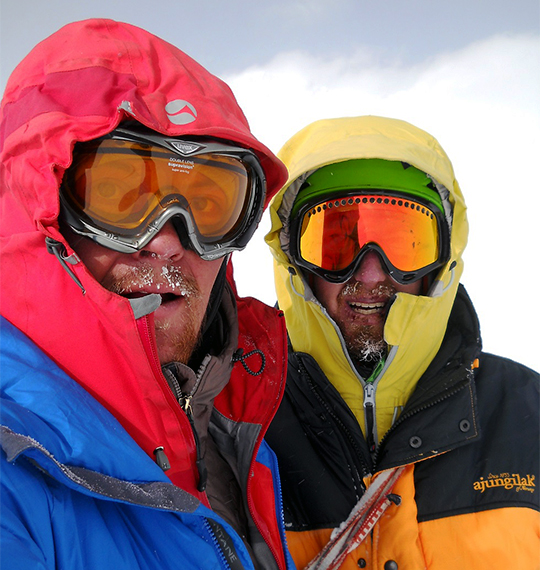
[Photo] Mikhail Fomin/Nikita Balabanov collection
The route started at 5600 meters by climbing over a large bergschrund at the cliff base, followed by hard vertical mixed terrain (M6) that led to difficult thin-crack aid climbing (A3) requiring pitons. Above, the pair climbed past a cornice and up thin ice on slabs with little protection.
The climbing on the first three days mimicked the initial pitches, with hard thin ice over brittle rock, long run-outs and dodgy protection. Bivouacs platforms were hacked into snow and ice, some taking two hours to excavate.
On the third day they climbed around a large gendarme, then up more thin ice. About halfway up the pillar, between Camps IV and V in the photo, is a wide rock band, which had been a question mark in the climbers’ minds since leaving base camp. Like the lower half of the route, the band yielded hard mixed climbing on thin ice over rock slabs.

[Photo] Mikhail Fomin/ Nikita Balabanov collection
Above the technical climbing, the pair climbed fast and reached an ice ramp that led to the summit ridge. Here they chopped out a ledge for their tent. On their next day, October 23, they topped out.
“Our surrounding was like in a dream–the east face of Jannu and the south face of Kangchenjunga. We took some photos and a video panorama, ate a chocolate bar and ice cream from frozen energy gels and in half an hour started our descent.” The pair descended the west side of Mt. Talung, bivouacking at 6700 meters.
Their descent was down the west side of Mt. Talung, as they’d planned, with one bivouac at 6700 meters.
They named the route Daddy Magnum Force for all the difficulties they encountered during the trek to the peak and the acclimatization phrase. Fomin says, ” We recollected a favorite phrase of a mutual friend: ‘Guys, Daddy Magnum Force is taking care of you, and this is a small test from him to check whether you are persistent enough with your intentions.'”
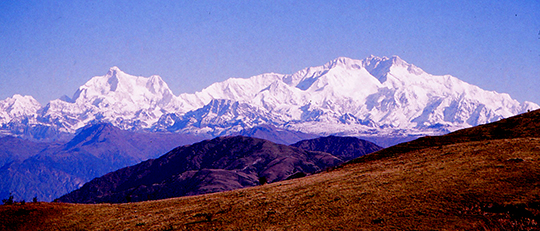
[Photo] Cameron M. Burns
Fomin and?Balabanov’s route recently won the coveted Crystal Peak award. The award was created by the magazine and website?risk.ru?and?is given for various outdoor activities, including mountaineering, to citizens of the nations that made up the former USSR. Registered users of the website vote in one of four categories: best climb, best trek, best social project, and best outdoor project. Sixty percent of the voters chose?Daddy Magnum Force in the?climbing category.